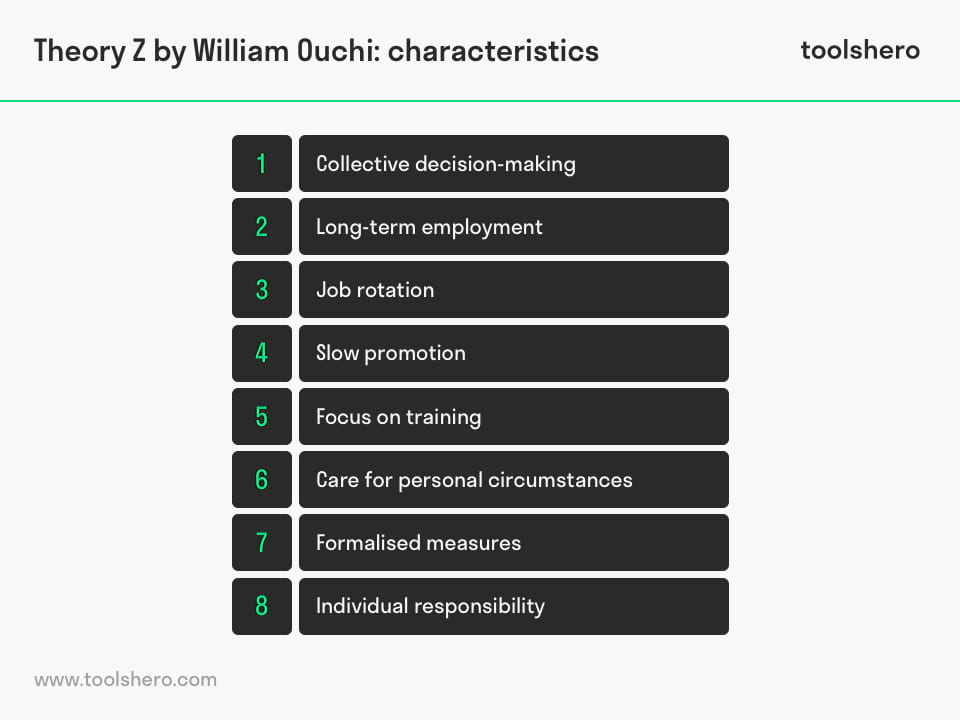Theory Z Was First Described by
Second human behavior is purposeful and motivated by a need for satisfaction. Anyone born between 1981 and 1996 ages 23 to 38 in 2019 is considered a Millennial and anyone born from 1997 onward is part of a new generation.

Theory X Theory Y And Theory Z Introduction To Business Deprecated
The benefits of Theory Z Ouchi claimed would be reduced employee turnover increased commitment improved morale and.

. In addition each electron has a spin quantum number ms that can be equal to 1212. For a Herzbergs approach Chris can push Angela towards committing to the Balloon School on weekends that way she can experience new challenge as well as a new accomplishment. And Japanese management styles with the Theory Z approach.
William Ouchis so-called Japanese Management style popularized during the Asian economic boom of the 1980s. Porter and Lawlers Expectancy Theory. First human needs are never completely satisfied.
William Ouchi developed Theory Z after making a comparative study of Japanese and American management practices. In this blog we have discussed a complete detail to McGregors Theory X and Theory Y. Long before the term influencer was coined young people played that social role by creating and interpreting trends.
Theory Z was first described by ___. Vrooms Expectancy Theory 8. How American management can Meet the Japanese.
Urwicks Theory Z 6. According to ___ how much people are willing to contribute to an organization depends on their assessment of the fairness or equity of the rewards they will receive in exchange. Gen Zers cynicism derives from growing up in a time of rampant misinformation leaders they view as dishonest and the constant negativity theyve seen in the media and on social media.
A type Z organisation has three major featurestrust subtlety and intimacy. Maslows Need Hierarchy Theory 2. Since the oldest among this rising generation are just turning 22 this year and most are still in their teens or younger we hesitated at first to give them a name Generation Z the iGeneration.
Recently I read an article in HR Magazine written by 16-year old Josh Miller a thought leader on all things Generation ZDespite his young age Miller spoke eloquently from a first-person perspective comparing and contrasting Generation Z with other generations. The two-factor motivation theory otherwise known as Herzbergs motivation-hygiene theory or dual-factor theory argues that there are separate sets of mutually exclusive factors in the workplace that either cause job satisfaction or dissatisfaction Herzberg 1966. Abraham Maslow a psychologist and pioneer in human motivation developed a theory of motivation based upon human needs that had three assumptions.
The first stage of Eriksons theory of psychosocial development occurs between birth and 1 year of age and is the most fundamental stage in life. This theory was first introduced in his book The Human Side of Enterprise It generally highlights two different management styles such as. Some of the most important theories of motivation are as follows.
William Ouchi developed Theory Z also called the Japanese management style that features a combination of the other styles. Third these needs can be classified according to a hierarchical structure of importance from the lowest to highest Maslow 1954. According to ____ how much people are willing to contribute to an organization depends on their assessment of the fairness or equity of the rewards they will receive in exchange.
To search for studies that utilize these theories and apply. Members of Gen Zloosely people born from 1995 to 2010are true digital natives. McGregors Participation Theory 5.
Now a new generation of influencers has come on the scene. Theory Z was first identified as a unique management approach by William Ouchi. He referred to these opposing motivational methods as Theory X and Theory Y management.
Theory Z was developed by not by Mcgregor but by William Ouchi in his book 1981 Theory Z. In his 1960 book The Human Side of Enterprise McGregor proposed two theories by which managers perceive and address employee motivation. Each assumes that the managers role is to organize resources including people to best benefit the company.
Figure compares the traditional US. Because an infant is utterly dependent developing trust is based on the dependability and quality of the childs caregivers. With his article as both a source and inspiration these ten defining characteristics of Generation Z will.
First describe exactly what Chris should do and then explain how the proposed managerial action is supported by Herzbergs theory. Theory Z suggests that large complex organisations are human systems and their effectiveness depends on the quality of humanism used. The Theory-Theory of concepts is a view of how concepts are structured acquired and deployed.
First things first - Theory Z is not a Mcgregor idea and as such is not Mcgregors extension of his XY theory. Concepts as they will be understood here are mental representations that are implicated in many of our higher thought processes including various forms of reasoning and inference categorization planning and decision making and constructing and. Herzberg Mausner Snyderman 1959.
Herzbergs Motivation Hygiene Theory 3. How American Management Can Meet the Japanese Challenge. Ouchi contrasted American types of organizations Type A that were rooted in the United States tradition of individualism with Japanese organizations Type J that drew upon the Japanese heritage of collectivism.
He calls it Theory Z. Theory Z of Ouchi is Dr. And Japanese business practices.
For Ouchi Theory Z focused on increasing employee loyalty to the company by providing a job for life with a strong focus on the well-being of the employee both on and off the job. Theory Z is an integrated model of motivation. So it makes sense that less than half of the participants would describe themselves as very trusting.
Theory Z of employee motivation includes many elements associated with the _____ approach to management. Theory Z was first described by ____. In this style of management workers are highly cooperative and.
The descriptions below are from The IR Theory Web Site created by Mark Beavis of University of Southern Queensland Australia. Theory Z expounds a management style blending Japanese and US organisational values. Entries are supplemented using sources from the Credo Reference and Gale Virtual Reference Library databases with additional references to selected books and journal articles.
William Ouchi pronounced O Chee a management scholar at the University of California Los Angeles has proposed a theory that combines US. Developed by William Ouchi it emphasises a strong company philosophy a distinct corporate culture long-range development and employment consensual decision-making and moderately specialised career paths Adeniyi 2007. The magnetic quantum number ml with 2 l 1 values ranging from l to l describes the orientation of the orbital in space.
Gen Z leans toward skepticism lack of trust. Ouchis theory first appeared in his 1981 book Theory Z. The Theory X and Theory Y created by Douglas McGregor in 1950s and developed later in the 1960s.
No two electrons in the same atom can have the same set of values for all the four quantum numbers. McClellands Need Theory 4. From the very beginning when.
From earliest youth they have been exposed to the internet to social networks and to mobile systems.

Theory Z Organization Examples Advantages School Model Type Workplace Business Competitiveness

Theories Of Management Theory Z Theories Public Relations Management


Comments
Post a Comment